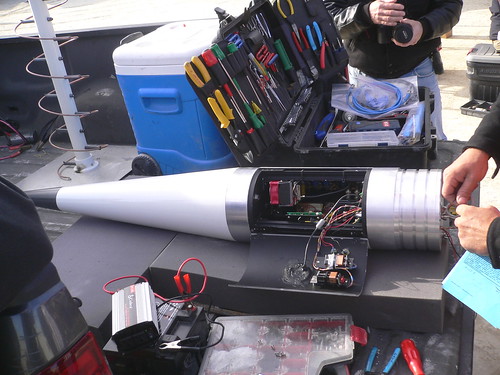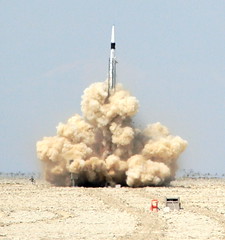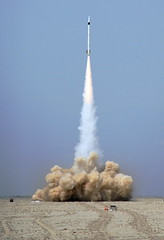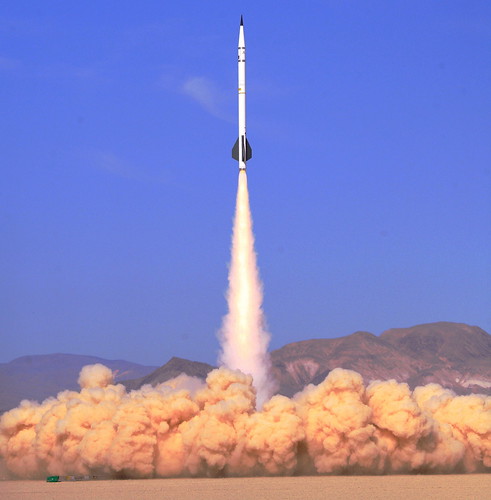Gene Nowaczyk is aiming for the big prize - a successful launch to 100,000 ft. After 50 hours/week over two years, he drove his custom airframe from Missouri in a huge truck.
Here is prepping the upper section, packed with electronics. He put an incredible amount of work and craftsmanship into this machined metal rocket. Video camera, x-ray measurements (for atmospheric air quality), avionics for GPS, barometric pressure, accelerometer and other sensors, telemetry...
The complexity of this 17 ft. tall rocket even captured the attention of WIRED magazine:
Gene has had his share of failure:
His homebrew Q motor is just huge, about 4x the total thrust of a cruise missile booster, or 64,000 Estes rocket engines, but an aged binder led to air pockets that caused a motor overpressure and rupture overhead.
He plans to build more of the same rocket design. I have witnessed two of his launches. His Q motor flame is 18.5 long. The sound was incredible, deep, and loud...
Our fingers were crossed. Off she roared to Mach 3.5
Success! This photo quickens my pulse.
Gene rocket recorded video during its record-setting launch at BALLS in the Black Rock Desert, Nevada. This is a frame grab from the video. The readings are in meters, so this sensor indicated an altitude of ~ 100K ft. The atmosphere ends at 55K ft at this latitude.
This launch was a highlight of the weekend, as celebrated on the cover of the New York Times.
The nosecone is now cooling from a peak of 425° during the ascent. The thermal expansion and contraction of the electronic leads led to a loss of power soon after apogee. But the rocket was recovered in almost perfect shape, with just the paint burned off the nose cone.
- Log in to post comments







100km is the Karman Line, the (somewhat arbitrary) boundary of the edge of space!
Impressive...
Seems apt as you can see the thin blue line.... quite the perspective.
Now imagine seeing this wireless video feed and wondering how long the hike will be to get the rocket back on reentry... =)
What are the other levels of measurement? Since you give the value of mach 3.5, that indications is in meters per second? Mein Gott that is quick.
The legend says it transmits telemetry to earth, do you know what frequency - band they use? The article states a over-sized satellite dish. I take it that they setting up 2/5m parabolic antennas to receive the signal. 18 Ghz? (2.4Ghz Wifi would be attenuated coming through the atmosphere) I'm assuming they must be using a licensed band that doesn't interfere with local air traffic or satellite transmissions. That's got to be difficult to track and keep the signal, fascinating stuff.
Not sure on the rocket's radio band, but I can ask if you want the details.
To clarify, the WIRED article confused the purpose of the big dish. That was connecting to a geosync military satellite for a broadband data link. So we had Skype on the playa, and inks to Google Earth so we can see the rocket GPS trajectory overlaid on the satellite imagery of the region in real time. Photo: http://www.flickr.com/photos/jurvetson/1516275369/
The rocket tracking is with a smaller dish that can manually pan up:
http://www.flickr.com/photos/jurvetson/1517098388
To clarify, the WIRED article confused the purpose of the big dish. That was connecting to a geosync military satellite for a broadband data link. So we had Skype on the playa, and inks to Google Earth so we can see the rocket GPS trajectory
thanks...blog
So we had Skype on the playa, and inks to Google Earth so we can see the rocket GPS trajectory overlaid on the satellite imagery of the region in real time